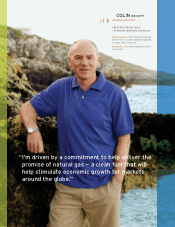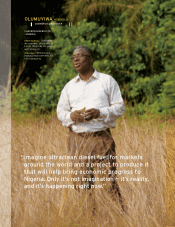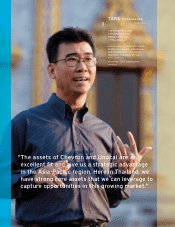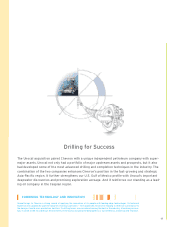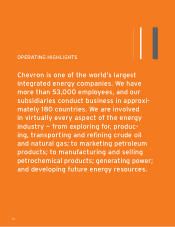Chevron 2005 Annual Report Download - page 23
Download and view the complete annual report
Please find page 23 of the 2005 Chevron annual report below. You can navigate through the pages in the report by either clicking on the pages listed below, or by using the keyword search tool below to find specific information within the annual report.
Chevron’s upstream business explores for and produces crude oil and natural gas.
We hold strategic positions in the world’s largest and most prolifi c regions, and we
are typically among the top three producers wherever we operate. During the year,
we made signifi cant progress in advancing our upstream strategy — to grow the
profi tability of our core areas of operation and to build new legacy positions.
CORE AREAS The Unocal acquisition greatly enhanced our position in the Asia-
Pacifi c region, the Caspian and the U.S. Gulf of Mexico, core areas where we already
had a signifi cant presence. We also continued to make good progress in maximizing
the value of our base business, primarily by lowering costs while increasing reli-
ability and production volumes. In the Gulf of Thailand, for example, we improved
production substantially by returning nonproducing wells to production and by
removing bottlenecks at several mature fi elds. Also during the year, we completed
the $1.7 billion sale of a wholly owned Canadian subsidiary of Unocal. The disposi-
tion was consistent with our recent divestiture of nonstrategic producing properties
in western Canada.
“BIG 5” In 2005, we moved forward with a number of major capital investments,
including our “Big 5” projects. Initial production began in early 2006 from the
Benguela Belize-Lobito Tomboco development offshore Angola. Construction began
on production facilities for the giant Agbami Field offshore Nigeria and the Tahiti
Field in the U.S. Gulf of Mexico. We made progress on the Tengizchevroil expansion
project in Kazakhstan, and we reached milestones in developing our vast natural gas
resources in the Greater Gorgon Area offshore Western Australia.
NATURAL GAS Commercializing our natural gas resources is an important part of
our upstream strategy. In addition to the Gorgon development, we are a partner in
the North West Shelf project offshore Western Australia, where a major expansion
is under way to increase liquefi ed natural gas (LNG) export capacity by approxi-
mately one-third. We also are pursuing a number of opportunities to import natural
gas into North America. We recently increased our capacity at the Sabine Pass LNG
import terminal, under construction in Louisiana, and we have fi led an application
to build an LNG regasifi cation terminal near our Pascagoula, Mississippi, refi nery.
Through the Sasol Chevron joint venture, we are developing a global business to
produce and market high-performing, ultraclean transportation fuels using gas-to-
liquids technology.
UPSTREAM
UPSTREAM AT A GLANCE
OPERATING HIGHLIGHTS
At the end of 2005, worldwide net proved crude oil and natural gas reserves for consolidated operations
were 9 billion barrels of oil-equivalent and for affi liated operations were 2.9 billion barrels. Production
averaged 2.5 million barrels of oil-equivalent per day, including volumes produced from oil sands and
production under an operating service agreement. Major producing areas are Angola, Australia, Indonesia,
Kazakhstan, Nigeria, the Partitioned Neutral Zone, Thailand, the United Kingdom, the United States and
Venezuela. Major exploration areas are Australia, Brazil, Canada, the Norwegian North Sea, Trinidad and
Tobago, the U.K. Atlantic Margin, the U.S. Gulf of Mexico, Venezuela and western Africa.
2005 MOMENTUM
• Began initial production from
developments in Angola, Azerbai-
jan, Bangladesh, Chad, Indonesia,
Thailand, Trinidad and Tobago, and
the United Kingdom
• Drilled signifi cant discoveries in
Angola, Cambodia, Nigeria, Trinidad
and Tobago, the U.S. Gulf of Mexico,
and Venezuela
• Acquired promising new offshore
acreage in Thailand, the U.K. Atlantic
Margin, U.K. North Sea, U.S. Gulf of
Mexico, Vietnam, Western Australia
and western Venezuela; onshore, the
successful bidder on a block in Libya
• Signed framework agreement with
joint-venture partners that will enable
the combined development of Gorgon
and nearby natural gas fi elds as one
world-class project; signed Heads of
Agreement with three Japanese utili-
ties for the sale of liquefi ed natural
gas (LNG) from Gorgon
• Moved major projects into engineering
and design phase — Gorgon LNG project;
Angola LNG project; Usan Field, deep-
water Nigeria
21
> Above, left to right: Steam pipes and expansion joints, McKittrick Field, San Joaquin Valley,
California. > Agbami Field, deepwater Nigeria.



